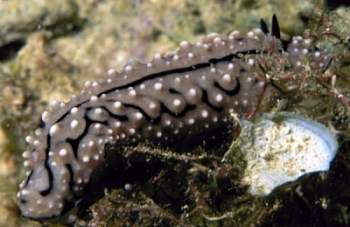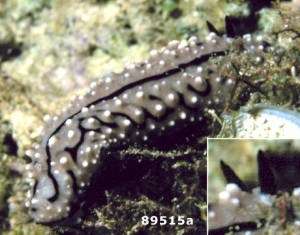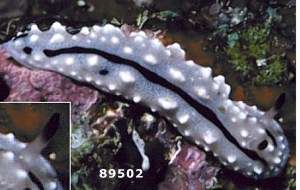
Phyllidiella cf. rudmani
Brunckhorst, 1993
Order: NUDIBRANCHIA
Suborder: DORIDINA
Superfamily: EUDORIDOIDEA
Family: Phyllidiidae
PHOTO
Milne Bay, Papua New Guinea, August 1995, depth unrecorded, estimated length about 45mm. PHOTO: M.J. Adams.
RELATED TOPIC
See message below.
Reference:
• Brunckhorst, D.J. (1993) The systematics and phylogeny of Phyllidiid Nudibranchs (Doridoidea). Records of the Australian Museum, Supplement 16: 1-107.
Rudman, W.B., 2000 (April 24) Phyllidiella cf. rudmani Brunckhorst, 1993. [In] Sea Slug Forum. Australian Museum, Sydney. Available from http://www.seaslugforum.net/find/phylcfru
Related messages
Re: Phyllidiella cf. rudmani
April 29, 2000
From: Mary Jane Adams

Dear Bill,
I found another slide of Phyllidiella cf. rudmani taken from a slightly higher angle. Looking at the slide with an 8 X loupe, I believe that the base of the rhinophore is white. (89515a)
While searching through my files, I found some other similar images. The one that looks the most like the photos of Phyllidiella rudmani on your webpage was shot in Milne Bay in August, 1995. Depth unrecorded, length approx. 40 mm. (89502)
However, I also have an image of another similar Phyllidiella from near Kavieng, PNG, that has completely white rhinophores. It was photographed in Sept 1998. Depth unrecorded, length 42mm. (99801)
This group of slugs is really confusing!
Thanks for your impressions,
Mary Jane Adams
mjadams@earthlink.net


Dear Mary Jane,
Thanks for the extra photos - not that they make the situation easier!
I think from your extra photo [89515a] that we can consider the rhinophore to have a 'pink' base which would suggest it is probably a colour form of P. rudmani. Your new photo [89502] is a pretty good fit to 'typical' Phyllidiella rudmani.
However your last photo [99801] is another puzzle. The compound tubercles are reminiscent of Phyllidiopsis krempfi or perhaps Phyllidiopsis pipeki as well as Phyllidiella rudmani. However the colourless rhinophores are a problem. The only Phyllidiopsis with similarly coloured rhinophores is Phyllidiopsis shireenae but the arrangement of black lines is rather different.
One possibility is that the rhinophores are regrowing after being damaged (eaten) which would suggest P. rudmani as a simple solution. Another problem however is that it seems to have rhinotubercles [the small tubercle associated with the rhinophore pocket in Phyllidia and Fryeria]. If so, I don't know what to suggest, other than to put it to one side at present.
I'm afraid there doesn't seem to be an easy solution,
Best wishes,
Bill Rudman.
Phyllidiella from Papua New Guinea
April 25, 2000
From: Mary Jane Adams

Dear Bill,
Can you identify this one? Milne Bay, Papua New Guinea, August, 1995, depth unrecorded, estimated length about 45mm.
Thanks so much for all the information you are providing on this website. I find it all very interesting and hope that the images I send will make some small contribution to better understanding of sea slugs.
Mary Jane
mjadams@earthlink.net
Adams, M.J., 2000 (Apr 25) Phyllidiella from Papua New Guinea. [Message in] Sea Slug Forum. Australian Museum, Sydney. Available from http://www.seaslugforum.net/find/2307Dear Mary Jane,
Your photos are indeed very interesting and this one is a good example.
The short answer is I can't identify it, which is interesting as it means it is either a new species or an unknown colour variation of a named species.
It looks quite like Phyllidiella rudmani in having white pustules and a pinkish mantle, but that species is not recorded to have swirly black lines between the black longitudinal line on each side and the mantle edge. If you by chance have a photo from another angle, preferably from above, I would like to see what other black lines it has. I assume it has another longitudinal black line to match the one we can see, bit I can't see if there are other black lines in the midregion. Also your animal seems to have a black rhinophore club while P. rudmani has a pink base. Perhaps the base of the rhinophore in your photo is obscured.
I think I will keep it separate as Phyllidiella cf. rudmani until we have some more information to go on.
Best wishes,
Bill Rudman.
